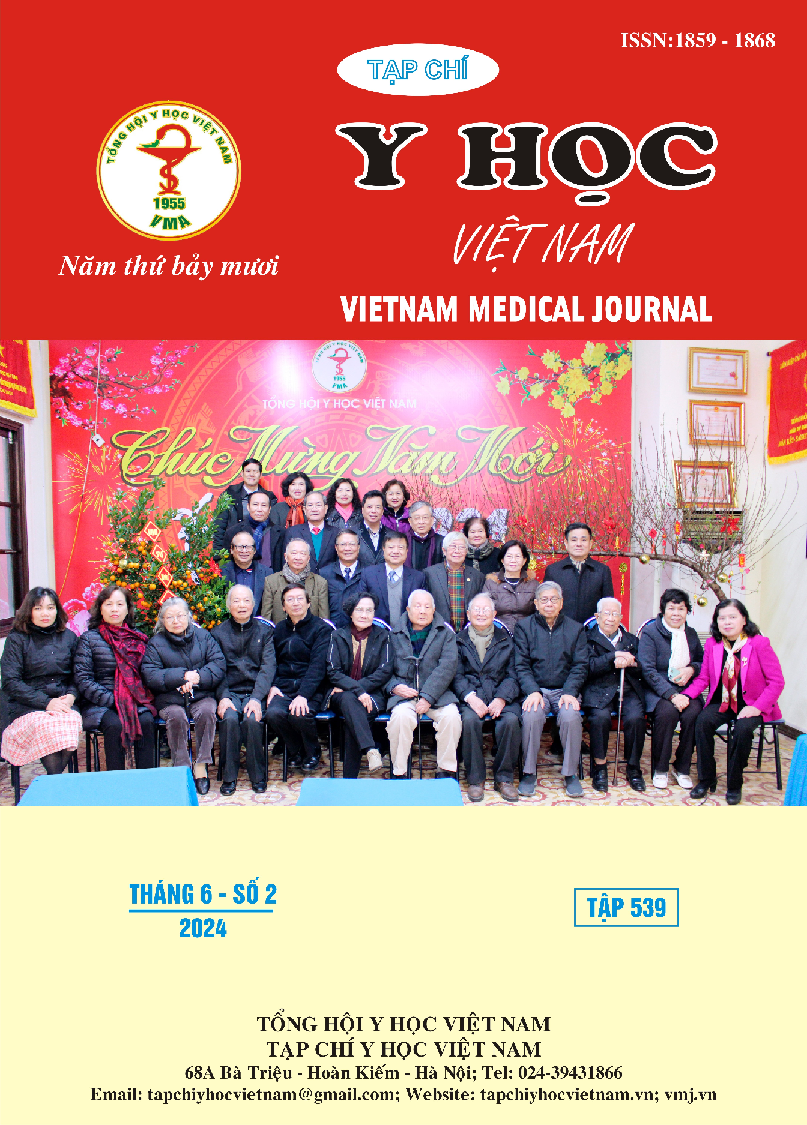THE ANTIBACTERIAL PROPERTIES OF SILVER NANOPARTICLES AGAINST ENTEROCOCCUS FAECALIS AND THE POSSIBILITY OF APPLYING NANO SILVER IN ENDODONTIC TREATMENT
Main Article Content
Abstract
Objectives: (1) To determine the minimum inhibitory concentration (MIC) and minimum bactericidal concentration (MBC) of AgNPs (5 - 7 nm) solution against E. faecalis bacteria. (2) Evaluate antibacterial effectiveness of AgNPs solution at the minimum bactericidal concentration against E.faecalis cultured in tooth roots for 21 days. Method: This in vitro study consisted of two parts. Part 1: Determining the minimum inhibitory concentration of AgNPs solution using the microdilution method on a microplate plate. Then determine the minimum bactericidal concentration of AgNPs according to the bacteria culture method on agar plates and the Real-time PCR testing method. Part 2: Irrigation the roots which were cultured of E.faecalis bacteria for 21 days with following solutions: group A (10 teeth) irrigated with 0.9% NaCl; group B (10 teeth) irrigated with AgNPs solution at minimum bactericidal concentration. Take a bacterial sample after irrigation with an absorbent paper cone in the root canal and perform a Real-time PCR test. Compare the average Ct index of the groups to evaluate the antibacterial effectiveness of AgNPs solution at the minimum bactericidal concentration against E.faecalis bacteria cultured in tooth roots for 21 days. Results: The minimum inhibitory concentration of AgNPs solution determined by microplate dilution technique was 62.5 ppm. The minimum bactericidal concentration of AgNPs solution determined by the bacteria culture method on agar plates and Real-time PCR testing method is 62.5 ppm. Results of irrigation in the tooth root after culturing E. faecalis bacteria for 21 days showed that 62.5 ppm AgNPs solution was as effective against E.faecalis bacteria as 0.9 % NaCl solution (p > 0.05). Conclusion: The minimum inhibitory concentration and minimum bactericidal concentration of AgNPs (5 -7 nm) solution is 62.5 ppm. The antibacterial effect against E. faecalis was cultured in tooth roots for 21 days of 62.5 ppm AgNPs solution equivalent to 0.9 % NaCl solution.
Article Details
Keywords
Silver, Nanoparticles, endodontic, Enterococcus faecalis
References
2. Rôças IN, Siqueira JF, Jr., Santos KR. Association of Enterococcus faecalis with different forms of periradicular diseases. J Endod. 2004; 30(5):315-20. doi:10.1097/00004770-200405000-00004
3. Sadek RW, Moussa SM, El Backly RM, Hammouda AF. Evaluation of the Efficacy of Three Antimicrobial Agents Used for Regenerative Endodontics: An In Vitro Study. Microbial drug resistance. 2019;25(5):761-771. doi:10.1089/mdr. 2018.0228
4. Nayyar P, Sethi A, Thakur D, et al. Antibacterial Effect of Silver Nanoparticle Gel as an Intracanal Medicament in Combination with Other Medicaments against Enterococcus faecalis: An In vitro Study. Journal of pharmacy & bioallied sciences. 2021;13 (Suppl 1):S408-s411. doi:10. 4103/jpbs.JPBS_600_20
5. Kushwaha V, Yadav RK, Tikku AP, et al. Comparative evaluation of antibacterial effect of nanoparticles and lasers against Endodontic Microbiota: An in vitro study. J Clin Exp Dent. Dec 2018;10(12) :e1155-e1160. doi:10.4317/jced. 55076
6. Krishnan R, Arumugam V, Vasaviah SK. The MIC and MBC of Silver Nanoparticles against Enterococcus faecalis - A Facultative Anaerobe. J Nanomed Nanotechnol. 2015;6:1-4. doi:10.4172/ 2157-7439.1000285
7. Ramkumar S, Natesan S, Gopal S, et al. Green synthesized silver nanoparticles from Garcinia imberti bourd and their impact on root canal pathogens and HepG2 cell lines. RSC Advances. 2017;55:34548–34555. doi:10.1039/ c6ra28328d
8. Tang S, Zheng J. Antibacterial Activity of Silver Nanoparticles: Structural Effects. Advanced healthcare materials. 2018;7(13):e1701503. doi: 10.1002/adhm.201701503
9. Trần Quang Huy, Lê Thiên Kim, Phạm Văn Chung, và cộng sự. Xác định định nồng độ ức chế tối thiểu của Nano Bạc đối với vi khuẩn gây bệnh bằng kỹ thuật vi phiến. Tạp chí Y học dự phòng.2015;3(163):31-36 20/04/2015. http://www.tapchiyhocduphong.vn/tap-chi-y-hoc-du-phong/2015/03/xac-dinh-nong-do-uc-che-toi-thieu-cua-nano-bac-doi-voi-vi-khuan-gay-benh-bang-ky-o81E20222.html
10. Cui J, Sun Q, Duan M, Liu D, Fan W. Establishment and characterization of silver-resistant Enterococcus faecalis. Folia Microbiol (Praha). 2020; 65(4):721-733. doi:10.1007/ s12223-020-00778-5


